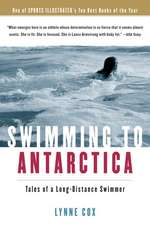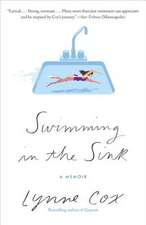Open Water Swimming Manual: An Expert's Survival Guide for Triathletes and Open Water Swimmers
Autor Lynne Coxen Limba Engleză Paperback – 29 iul 2013
Open Water Swimming Manual provides a wealth of knowledge for all swimmers, from seasoned triathletes and expert swimmers to beginners exploring open water swimming for the first time. It is, as well, the first manual of its kind to make use of oceanography, marine biology, and to weave in stories about the successes and failures of other athletes, giving us a deeper, broader understanding of this exhilarating and fast growing sport.
Preț: 134.00 lei
Nou
Puncte Express: 201
Preț estimativ în valută:
25.64€ • 26.83$ • 21.30£
25.64€ • 26.83$ • 21.30£
Carte disponibilă
Livrare economică 08-14 martie
Livrare express 26 februarie-04 martie pentru 21.60 lei
Preluare comenzi: 021 569.72.76
Specificații
ISBN-13: 9780345806093
ISBN-10: 0345806093
Pagini: 313
Ilustrații: ILLUSTRATIONS AND CHARTS
Dimensiuni: 132 x 233 x 18 mm
Greutate: 0.4 kg
Editura: VINTAGE BOOKS
ISBN-10: 0345806093
Pagini: 313
Ilustrații: ILLUSTRATIONS AND CHARTS
Dimensiuni: 132 x 233 x 18 mm
Greutate: 0.4 kg
Editura: VINTAGE BOOKS
Recenzii
Praise for Lynne Cox and Open Water Swimming Manual
"Lynne Cox’s books are the works of a singular mind. That was true for the best sellers Swimming to Antarctica and Grayson, and it is true for her new book, Open Water Swimming Manual, a 300-page paperback instructional that is the most unlikely page-turner you could put on your summer reading list. She’s written a sort of fantasy in which you, the reader, are the protagonist. You can’t swim half a mile? Cox will put you on a program to swim 10! . . . Cox’s Open Water Swimming Manual could do for long-distance swimming what Jim Fixx’s The Complete Book of Running did for the American jogging movement in 1977."
—Sports Illustrated
"Lynne Cox is an artist of the open water. No one knows more about swimming's beauty and skill than this great champion, or could describe it with such clarity and grace. Every sport—every art—should have a book like this and a guide like Lynne Cox."
—Christopher McDougall, author of Born to Run
"Lynne Cox’s books are the works of a singular mind. That was true for the best sellers Swimming to Antarctica and Grayson, and it is true for her new book, Open Water Swimming Manual, a 300-page paperback instructional that is the most unlikely page-turner you could put on your summer reading list. She’s written a sort of fantasy in which you, the reader, are the protagonist. You can’t swim half a mile? Cox will put you on a program to swim 10! . . . Cox’s Open Water Swimming Manual could do for long-distance swimming what Jim Fixx’s The Complete Book of Running did for the American jogging movement in 1977."
—Sports Illustrated
"Lynne Cox is an artist of the open water. No one knows more about swimming's beauty and skill than this great champion, or could describe it with such clarity and grace. Every sport—every art—should have a book like this and a guide like Lynne Cox."
—Christopher McDougall, author of Born to Run
Cuprins
Table of Contents
Introduction
Part One: How to Begin
Chapter 1: Beginnings
Allure of the Open Water
Expert Sources & Credentials
Chapter 2: Equipment
The Swimsuit
Swimsuit Care
Chafing
Skin Lubricant Products
Treatment for Chafing
Sunscreen Products
Sunburn Prevention
Sunburn Treatment
Goggles
Swim Caps
Wet Suits
Swim Skins
Chapter 3: Finding an Open Water Swimming Coach and Group
Finding Specific Coaches and Groups
Chapter 4: Technical Skills for Open Water Swimming
Swimming Skills Required
Breathing Drills
Head Position in the Water
Feeling the Water to Swim Faster
Chapter 5: Research
Selecting a Training Area
Scouting/Walking the Workout Course
Tidal Charts
Water Temperature
Water Quality
Food and Hydration
Chapter 6: Into the Open Water
The Stingray Shuffle
Water Entry
Bodysurfing
Waves
Surf
Role of the Tides
Swell Prediction
Moving through the Surf
Over Our Heads: Distress Signals
Riptides
Water Exit
Chapter 7: Effects of Heat and Cold
Cold Acclimatization
Hyperthermia and Hypothermia
Heat Acclimatization
Hypothermia
Ice Swimming
After-drop
Chapter 8: Sinuses and Ears
Prevention of Infections
Chapter 9: Ocean Hazards
Fog
Ships, Boats, Jet Skis, Sailor Boats, Wind Surfers, Kite Surfers, and Surfers
Part Two: Beginning and Intermediate Swimmers
Chapter 10: Training Swims
Training Safely
Training for a Short Open Water Swim
Training for a Moderate or Long Open Water Swim
Chapter 11: Selection For Support & Swim
Skills Required for Kayaker
Kayaker Selection
Kayaker Competency
Swimming Route
Part Three: Intermediate & Advanced Swimmers
Chapter 12: Open Water Swims Outside the Buoys with Boat Support
Information Gathering/Research
Selecting Support Crew
One Person on the Surface in Charge
Plan for Swim/Mission
Briefing: Explaining the Plan
SEAL Mission Planning
Strategy
Backup Plans
Safety/Operational Risk Management
Emergency Action Plan
Completion of Swim and Rewarming
Debriefing
Further SEAL Advice When Planning a Swim
Recommendations for Long Training Swims and Documentation
Chapter 13: Dangerous Marine Organisms
Research Semitropical and Tropical Waters before Swimming
Bristle Worms
Coral Reefs
Fire Coral
Jellyfish
Box Jellyfish
Leptospirosis
Seabather’s Eruption
Sea Cucumbers
Sea Urchin
Seaweed Dermatitis
Scorpion Fish
Crown-of-Thorns Starfish
Stonefish
Stingrays
Country Medicine
Swimmer's Itch
SEALs Recommend U.S. Navy Diving Manual
Chapter 14: Sharks
Swimming with Sharks and Rays
Minds In the Water
U.S. Navy Diving Manual on Sharks
First Aid for Shark Bites
Part Four: Advanced Swimmers
Chapter 15: Into the Dark
Swimming in the Dark
Dark Swims and Illumination
Finding Better Illumination
Chapter 16: Sea Sickness
Taking Medications During a Swim
Chapter 17: Preparation
Physical Training
Mental Preparation
Chapter 18: Going In and out of Consciousness
Deep Mind “Thing”
Sleep
Chapter 19: Motivations
Success
Success in Unsuccessful Swims
Chapter 20: The English Channel Charts, Contacts, and Pilots
Tidal Charts
You Want to Swim the English Channel?
How Do You Make Contact?
Selecting a Pilot
Chapter 21: Catalina and Other Channel Swims
The Catalina Channel Swim
The Santa Barbara Channel Swim
Finding Pilots For the Catalina Channel and Other Swims
Meeting With Pilots Before Hiring Them
Inspect the Boat Before You Swim
Before You Begin Any Channel Swim
Contact the U.S. Coast Guard
Staying Healthy
Boating Safety
Selecting Boat Support for an Organized Swim
Organized Swim Considerations
Chapter 22: Swimmer’s Utopia
Chapter 23: Stewardship of the Waters
Sources for Additional Information
Acknowledgments
Index
Introduction
Part One: How to Begin
Chapter 1: Beginnings
Allure of the Open Water
Expert Sources & Credentials
Chapter 2: Equipment
The Swimsuit
Swimsuit Care
Chafing
Skin Lubricant Products
Treatment for Chafing
Sunscreen Products
Sunburn Prevention
Sunburn Treatment
Goggles
Swim Caps
Wet Suits
Swim Skins
Chapter 3: Finding an Open Water Swimming Coach and Group
Finding Specific Coaches and Groups
Chapter 4: Technical Skills for Open Water Swimming
Swimming Skills Required
Breathing Drills
Head Position in the Water
Feeling the Water to Swim Faster
Chapter 5: Research
Selecting a Training Area
Scouting/Walking the Workout Course
Tidal Charts
Water Temperature
Water Quality
Food and Hydration
Chapter 6: Into the Open Water
The Stingray Shuffle
Water Entry
Bodysurfing
Waves
Surf
Role of the Tides
Swell Prediction
Moving through the Surf
Over Our Heads: Distress Signals
Riptides
Water Exit
Chapter 7: Effects of Heat and Cold
Cold Acclimatization
Hyperthermia and Hypothermia
Heat Acclimatization
Hypothermia
Ice Swimming
After-drop
Chapter 8: Sinuses and Ears
Prevention of Infections
Chapter 9: Ocean Hazards
Fog
Ships, Boats, Jet Skis, Sailor Boats, Wind Surfers, Kite Surfers, and Surfers
Part Two: Beginning and Intermediate Swimmers
Chapter 10: Training Swims
Training Safely
Training for a Short Open Water Swim
Training for a Moderate or Long Open Water Swim
Chapter 11: Selection For Support & Swim
Skills Required for Kayaker
Kayaker Selection
Kayaker Competency
Swimming Route
Part Three: Intermediate & Advanced Swimmers
Chapter 12: Open Water Swims Outside the Buoys with Boat Support
Information Gathering/Research
Selecting Support Crew
One Person on the Surface in Charge
Plan for Swim/Mission
Briefing: Explaining the Plan
SEAL Mission Planning
Strategy
Backup Plans
Safety/Operational Risk Management
Emergency Action Plan
Completion of Swim and Rewarming
Debriefing
Further SEAL Advice When Planning a Swim
Recommendations for Long Training Swims and Documentation
Chapter 13: Dangerous Marine Organisms
Research Semitropical and Tropical Waters before Swimming
Bristle Worms
Coral Reefs
Fire Coral
Jellyfish
Box Jellyfish
Leptospirosis
Seabather’s Eruption
Sea Cucumbers
Sea Urchin
Seaweed Dermatitis
Scorpion Fish
Crown-of-Thorns Starfish
Stonefish
Stingrays
Country Medicine
Swimmer's Itch
SEALs Recommend U.S. Navy Diving Manual
Chapter 14: Sharks
Swimming with Sharks and Rays
Minds In the Water
U.S. Navy Diving Manual on Sharks
First Aid for Shark Bites
Part Four: Advanced Swimmers
Chapter 15: Into the Dark
Swimming in the Dark
Dark Swims and Illumination
Finding Better Illumination
Chapter 16: Sea Sickness
Taking Medications During a Swim
Chapter 17: Preparation
Physical Training
Mental Preparation
Chapter 18: Going In and out of Consciousness
Deep Mind “Thing”
Sleep
Chapter 19: Motivations
Success
Success in Unsuccessful Swims
Chapter 20: The English Channel Charts, Contacts, and Pilots
Tidal Charts
You Want to Swim the English Channel?
How Do You Make Contact?
Selecting a Pilot
Chapter 21: Catalina and Other Channel Swims
The Catalina Channel Swim
The Santa Barbara Channel Swim
Finding Pilots For the Catalina Channel and Other Swims
Meeting With Pilots Before Hiring Them
Inspect the Boat Before You Swim
Before You Begin Any Channel Swim
Contact the U.S. Coast Guard
Staying Healthy
Boating Safety
Selecting Boat Support for an Organized Swim
Organized Swim Considerations
Chapter 22: Swimmer’s Utopia
Chapter 23: Stewardship of the Waters
Sources for Additional Information
Acknowledgments
Index
Notă biografică
Lynne Cox was born in Boston, Massachusetts, and grew up in Los Alamitos, California, where she presently lives. She has held open-water swimming records all over the world, for among others, the fastest crossing of the English Channel (at age 15), the Santa Catalina Channel, the twelve-mile Oresund between Denmark and Sweden, and the Kattegut between Norway to Sweden. Cox was the first woman to swim across the Cook Strait in New Zealand, the first to swim across the Strait of Magellan, the Beagle Channel between Argentina and Chile, Lake Baikal in Russia, and around the Cape of Good Hope. In 1987, Cox crossed the Bering Strait to the Soviet Union, and in 2002 swam more than a mile in the 31°F waters off Antarctica. Cox has been inducted into the International Swimming Hall of Fame. She is the author of Swimming to Antarctica, Grayson, South with the Sun. Her articles have appeared in many publications, among them The New Yorker and the Los Angeles Times Magazine.
"The greatest open water swimmer." —Sports Illustrated
"The greatest open water swimmer." —Sports Illustrated
Extras
Excerpted from Chapter 1
Beginnings
Allure of the Open Water
Oceans, lakes, rivers, ponds, and streams are some of the most beautiful places on earth to swim. Nothing compares with breaking free from the confines of a swimming pool and swimming in salty or sweet waters, as far as your arms will carry you. You are immediately lifted by the water, bounced by the waves, and massaged by the movement of your body through the water.
You feel sunshine warming your back, see shafts of sunlight illuminate the water below, hear the song of the wind and the waves, and as you swim, you hear the rhythms of your hands and feet as they catch and move water. You hear the music of your body and your breath as the wind, current, swell, and tide change, and the sounds of your body changing with it. You are immersed in this water song, and each day it is different.
Each day is a great adventure. You never know what you will experience until you get in and swim.
For forty years I have swum in the open water. At age fourteen I swam across the Catalina Channel and, at age fifteen, broke the men’s and women’s world records for the English Channel. Since then, I’ve completed sixty challenging open water swims—some were world-record swims, others were firsts, and all offered unique, exciting, and interesting challenges.
The sport of open water swimming is exploding like jogging did in the 1970s in the United States and Britain. There are more than nine hundred competitive open water swims across the United States throughout the year. There is a booming business in swim travel, in which swimmers travel to beautiful and exotic places like Greece, Turkey, and the Caribbean and participate in open water camps and swim along shore, between islands, and across straits.
The reason for this phenomenal growth in the sport may be because triathlon and open water swimming have gained Olympic status, since 2000 and 2008, respectively. According to the Sporting Goods Manufacturers Association (SGMA), an estimated 2.3 million people completed a triathlon in 2010, an increase of 55 percent from the year before, and the New York Triathlon sold out in eleven minutes despite an entry fee just shy of nine hundred dollars (see Sources for more information; page 299).
Thomas Johnson, former president and current open water swim director of the Triathlon Club of San Diego (see Sources for website address; page 299), has watched this amazing growth and was involved with organizing the 2012 ITU World Triathlon San Diego, which served as the second qualifier for the 2012 U.S. Olympic Triathlon team. He predicted that the sport would expand even more after the Olympic qualifying event and Olympic Games.
John Martin, the communications and media relations manager at USA Triathlon, said there were 122,388 USA Triathlon members in 2000 and by 2012 there were 636,335 members. Martin said:
There are many reasons such as: society’s interest in fitness and living a healthy lifestyle, the growth of the number of total races across the country, making events easier to get to, the growth in the number of the more accessible shorter sprint distance races, which made the sport more accessible to those with fewer hours to train each week, growth in the 30ߝ49 age groups who are looking for varied outlets for fitness, an increase in the number of USA Triathlon clubs, which fosters a community concept for men and especially women who enjoy the group training and support atmosphere, an increase in resources (websites, books, magazines) that provide assistance/education in getting started, growth in multisport shops and triathlon specific training and racing gear, marketing and communications efforts of USA Triathlon, the growth in the number of USA Triathlon certified coaches who are able to provide training plans and individual attention for athletes who need guidance and motivation, and USA Triathlonߝsanctioned 4,300 multisport events in 2011.
This enormous expansion of triathlon has had a huge impact on the growth of open water because swimming is one of the races included in the triathlon. There has been a dramatic increase in media visibility and interest in both triathlon and open water swimming. Young swimmers are also participating in the sport, especially those who have been involved in junior lifeguard programs. Some university and college swimming coaches are incorporating open water swims during long-distance winter training sessions, to give the athletes a break from swimming thousands of mind-numbing meters in the pool. The swimmers are enjoying the challenge of swimming in the wild blue waters. Young and older swimmers who have spent years of their lives swimming back and forth in pools are reading books and magazines about open water swimming and triathlons and are inspired to swim in untamed water. They want to train, set open water swimming goals, and discover ways to make the extreme environment of the open water accessible for themselves.
Last year there were record numbers of people swimming the English Channel (between England and Europe) and the Catalina Channel (between Catalina Island and the mainland of California). The sport has become so popular that British television now broadcasts open water swims during prime time.
What most athletes don’t realize is that open water swimming is a high-risk sport. This lack of awareness became very apparent to me on three separate occasions. The first occurred when a swimming friend in Laguna Beach, California, invited me to join him for an early dip. The fog was rolling in rapidly, reducing visibility to three hundred yards. We decided to swim only one hundred yards out to a buoy and then back in, because the fog was growing thicker, and we knew there was a chance of getting lost, even close to shore.
We met four triathletes, two men who had trained in the area a few times and two women who had never swum off that beach. They were planning to swim out to the buoy, parallel the shore, and swim toward cliffs about a half mile and back. One of the women asked if I would join them, and I said I didn’t think it was safe.
They were wearing wet suits and dark caps, and they set off into a rolling wall of fog that quickly erased the sounds of their strokes and consumed them. Had they considered what would happen to them if the fog suddenly grew thicker; what they would do if they became separated or disoriented? Did they know how to find their way back to shore? Did they realize that they were completely invisible in the fog? Did they realize boaters and Jet Skiers wouldn’t be able to see them and could easily run over them? They were oblivious to the risk they had taken or their responsibility to ensure the safety of their group. They were lucky they made it back without a problem.
A few weeks later, a friend who was just learning how to swim in the ocean was swimming parallel to shore outside the surf line. He had completed his workout and was turning in to the beach to swim to shore.
He forgot that he needed to look back to check the surf conditions. He was completely unaware that the dark blue long bump in the ocean was a wave growing behind him. He did not realize that this wave was a shore break. He suddenly felt the wave rapidly lifting him higher and higher and higher, tipping him forward and launching him into the air. He felt himself falling and the water rushing around him and suddenly pounding him into the beach.
He closed his eyes and felt himself flipping over the falls as tons of water crashed onto his body. He spun around and tried to find air, but the white water filled with sand was holding him under. His head finally broke the surface for a moment, and he gasped for a breath and tried to get his feet under him, but another wave, just as large, crashed on him and bounced him like a basketball on the beach.
He was submerged for what seemed like forever, but at last he planted his feet, stood up, and stumbled toward shore. The rip created by the backwash dragged him backward into the path of the approaching wave.
For the first time, he glanced over his shoulder and saw the next wave cresting. He leaned forward and, using his core strength, fought the backwash, pushed hard into the sand with feet, and staggered out of the water, coughing, his goggles twisted on his head, sand streaming down his face, shoulders, chest, sides, and filling his swimsuit. He looked up at his friends who had run down the beach to help him. He waved and smiled sheepishly and said he was okay. He understood that he could have been severely hurt in the shore break.
Shortly after that, I watched another swimmer, in his midforties, swimming off Seal Beach, California. He was breathing only on the right side of his body, so he was completely blind on the left. Because of this breathing pattern, he pulled stronger with his right arm than with his left. He had no spatial awareness, no sense of ocean navigation, and he could not see that he was swimming right into an area of heavy boating traffic. He had no idea that he was putting himself in danger. He was okay once he reached shore.
It was because of these events and many others that I realized there needed to be a book for all levels of open water swimmers, including those of us who have been swimming in the open water for years but still have so much to learn.
Scientists, physicians, lifeguards, and other experts offered to provide key information to help swimmers become more aware of the open water environment and to know how to handle themselves in the water.
Expert Sources and Credentials
Even though I’d completed swims in remote parts of the world and I’d worked with various navies and coast guards to achieve my goals, I knew that there was so much more to know about seamanship, risk management, and other topics connected to open water swimming.
A friend in the United States Air Force offered to put me in touch with the U.S. Navy SEALs. The SEALs are members of the United States Naval Special Warfare unit, or NSW, who are trained for unconventional warfare; “SEAL” is an acronym for “sea, air, and land.” NSW is the agency that provides units to conduct maritime special operations, since the SEALs are America’s elite maritime force. They know more about operational risk management than anyone; they are the experts in assessing, reducing, and mitigating risks. They have established protocols that they abide by to ensure safety. They are experts in seamanship, can work in teams, and know how to survive in the wildest ocean conditions.
The SEALs welcomed me to their base in Coronado, California, to observe their sessions with the trainees, instructors, and officers, to see the best in the world train, to understand the way the elite force implements safety measures, and to observe how everything is done in a completely professional way.
I was allowed to sit in during the instructors’ discussions about the trainees, which enabled me to understand the amount of planning, discussion, and attention to detail that goes into each training evolution, or session. They discussed everything in precise detail: how to initiate drills and exercises, how long each one will last, how to ensure the trainees’ safety, how often the trainees hydrate, how frequently the metal scuba tanks sitting in the hot sun are cooled to prevent the trainees from being burned. They reviewed how they would inspect each trainee, what errors to check for, and the number of push-ups trainees would do if they made a mistake. They also let me see the high-risk documentation that ensured the trainees’ safety. Equally important, the SEALs let me see the level of qualification required by every instructor who supervises a training event, whether it’s something as simple as a run or as complex as a dive.
The senior SEAL who contributed so much invaluable information, anecdotal stories, and guidance cannot be named because he is on active duty, so I will refer to him as L. Tadeus. His credentials are tremendously impressive. He enlisted in the U.S. Navy, earned his commission as an officer, and spent fourteen years working in the U.S. Navy SEAL teams—eight years operational and six years in a high-risk training capacity, supervising almost every type of high-risk maritime training conducted by Special Operations Forces (SOF). He has spent three years specifically conducting physical training events, from 2-mile to 5.5-mile (3.2-kilometer to 8.8-kilometer) swims and 4-mile (6.4-kilometer) runs. He is a Combatant Dive Training subject matter expert; Command Diving Officer and Diving Supervisor; Submersible Pilot/Navigator; and Military Small Craft Operator. The SEAL is trained in all levels of Operational Risk Management, is a Military Master Training Specialist (MTS) 9502 NEC, and has earned numerous civilian maritime certifications, up to and including two-hundred-ton boats, and is a certified Captain Near Coastal (International Yacht Training [IYT]).
Among L. Tadeus’s many training credentials is an additional qualification that made a huge difference to this manual. Like other senior SEALs, he has analyzed and investigated accidents that occurred during training. When he was not the actual Investigating Officer, he closely followed safety mishap investigations in cooperation with his Command Safety Manager to ensure that appropriate lessons were learned, and he institutionalized those lessons within the training curriculum so that no one would have to relearn them the hard way. He offered me many helpful illustrations of dangerous swim-training scenarios. He provided recommendations for finding support boats and people, equipment, and methods for incorporating risk management into open water swimming. He also gave me pearls of wisdom that he earned and learned through challenging experiences as a SEAL, an instructor, and a leader. He shared his knowledge generously to help open water swimmers swim safely and to help them achieve their worthy goals.
Rick Knepper also provided invaluable information. Rick is a sixty-three-year-old retired Navy SEAL Master Chief who has spent the past forty-five years with the Naval Special Warfare community, both for active duty and civil service. He has approximately thirty years working within the SEAL schoolhouse, with extensive time training SEAL candidates in all fundamental aquatic skills and surface swimming for ocean swims up to five and a half nautical miles. Additionally, he has been an aquatics trainer for numerous instructors’ staffs over the years and continues to fulfill this need when required. He has revised and designed various aquatic programs with the SEAL training pipeline and has served as an aquatics consultant with other navy organizations. For the past twenty-five years, Rick has been swimming open water marathons. At the age of fifty, he completed the Catalina Channel crossing and a local twenty-four-mile sanctioned solo swim off San Diego. He is currently training for a thirty-six-mile (57.9-kilometer) swim scheduled in 2013 off Coronado Island.
Beginnings
Allure of the Open Water
Oceans, lakes, rivers, ponds, and streams are some of the most beautiful places on earth to swim. Nothing compares with breaking free from the confines of a swimming pool and swimming in salty or sweet waters, as far as your arms will carry you. You are immediately lifted by the water, bounced by the waves, and massaged by the movement of your body through the water.
You feel sunshine warming your back, see shafts of sunlight illuminate the water below, hear the song of the wind and the waves, and as you swim, you hear the rhythms of your hands and feet as they catch and move water. You hear the music of your body and your breath as the wind, current, swell, and tide change, and the sounds of your body changing with it. You are immersed in this water song, and each day it is different.
Each day is a great adventure. You never know what you will experience until you get in and swim.
For forty years I have swum in the open water. At age fourteen I swam across the Catalina Channel and, at age fifteen, broke the men’s and women’s world records for the English Channel. Since then, I’ve completed sixty challenging open water swims—some were world-record swims, others were firsts, and all offered unique, exciting, and interesting challenges.
The sport of open water swimming is exploding like jogging did in the 1970s in the United States and Britain. There are more than nine hundred competitive open water swims across the United States throughout the year. There is a booming business in swim travel, in which swimmers travel to beautiful and exotic places like Greece, Turkey, and the Caribbean and participate in open water camps and swim along shore, between islands, and across straits.
The reason for this phenomenal growth in the sport may be because triathlon and open water swimming have gained Olympic status, since 2000 and 2008, respectively. According to the Sporting Goods Manufacturers Association (SGMA), an estimated 2.3 million people completed a triathlon in 2010, an increase of 55 percent from the year before, and the New York Triathlon sold out in eleven minutes despite an entry fee just shy of nine hundred dollars (see Sources for more information; page 299).
Thomas Johnson, former president and current open water swim director of the Triathlon Club of San Diego (see Sources for website address; page 299), has watched this amazing growth and was involved with organizing the 2012 ITU World Triathlon San Diego, which served as the second qualifier for the 2012 U.S. Olympic Triathlon team. He predicted that the sport would expand even more after the Olympic qualifying event and Olympic Games.
John Martin, the communications and media relations manager at USA Triathlon, said there were 122,388 USA Triathlon members in 2000 and by 2012 there were 636,335 members. Martin said:
There are many reasons such as: society’s interest in fitness and living a healthy lifestyle, the growth of the number of total races across the country, making events easier to get to, the growth in the number of the more accessible shorter sprint distance races, which made the sport more accessible to those with fewer hours to train each week, growth in the 30ߝ49 age groups who are looking for varied outlets for fitness, an increase in the number of USA Triathlon clubs, which fosters a community concept for men and especially women who enjoy the group training and support atmosphere, an increase in resources (websites, books, magazines) that provide assistance/education in getting started, growth in multisport shops and triathlon specific training and racing gear, marketing and communications efforts of USA Triathlon, the growth in the number of USA Triathlon certified coaches who are able to provide training plans and individual attention for athletes who need guidance and motivation, and USA Triathlonߝsanctioned 4,300 multisport events in 2011.
This enormous expansion of triathlon has had a huge impact on the growth of open water because swimming is one of the races included in the triathlon. There has been a dramatic increase in media visibility and interest in both triathlon and open water swimming. Young swimmers are also participating in the sport, especially those who have been involved in junior lifeguard programs. Some university and college swimming coaches are incorporating open water swims during long-distance winter training sessions, to give the athletes a break from swimming thousands of mind-numbing meters in the pool. The swimmers are enjoying the challenge of swimming in the wild blue waters. Young and older swimmers who have spent years of their lives swimming back and forth in pools are reading books and magazines about open water swimming and triathlons and are inspired to swim in untamed water. They want to train, set open water swimming goals, and discover ways to make the extreme environment of the open water accessible for themselves.
Last year there were record numbers of people swimming the English Channel (between England and Europe) and the Catalina Channel (between Catalina Island and the mainland of California). The sport has become so popular that British television now broadcasts open water swims during prime time.
What most athletes don’t realize is that open water swimming is a high-risk sport. This lack of awareness became very apparent to me on three separate occasions. The first occurred when a swimming friend in Laguna Beach, California, invited me to join him for an early dip. The fog was rolling in rapidly, reducing visibility to three hundred yards. We decided to swim only one hundred yards out to a buoy and then back in, because the fog was growing thicker, and we knew there was a chance of getting lost, even close to shore.
We met four triathletes, two men who had trained in the area a few times and two women who had never swum off that beach. They were planning to swim out to the buoy, parallel the shore, and swim toward cliffs about a half mile and back. One of the women asked if I would join them, and I said I didn’t think it was safe.
They were wearing wet suits and dark caps, and they set off into a rolling wall of fog that quickly erased the sounds of their strokes and consumed them. Had they considered what would happen to them if the fog suddenly grew thicker; what they would do if they became separated or disoriented? Did they know how to find their way back to shore? Did they realize that they were completely invisible in the fog? Did they realize boaters and Jet Skiers wouldn’t be able to see them and could easily run over them? They were oblivious to the risk they had taken or their responsibility to ensure the safety of their group. They were lucky they made it back without a problem.
A few weeks later, a friend who was just learning how to swim in the ocean was swimming parallel to shore outside the surf line. He had completed his workout and was turning in to the beach to swim to shore.
He forgot that he needed to look back to check the surf conditions. He was completely unaware that the dark blue long bump in the ocean was a wave growing behind him. He did not realize that this wave was a shore break. He suddenly felt the wave rapidly lifting him higher and higher and higher, tipping him forward and launching him into the air. He felt himself falling and the water rushing around him and suddenly pounding him into the beach.
He closed his eyes and felt himself flipping over the falls as tons of water crashed onto his body. He spun around and tried to find air, but the white water filled with sand was holding him under. His head finally broke the surface for a moment, and he gasped for a breath and tried to get his feet under him, but another wave, just as large, crashed on him and bounced him like a basketball on the beach.
He was submerged for what seemed like forever, but at last he planted his feet, stood up, and stumbled toward shore. The rip created by the backwash dragged him backward into the path of the approaching wave.
For the first time, he glanced over his shoulder and saw the next wave cresting. He leaned forward and, using his core strength, fought the backwash, pushed hard into the sand with feet, and staggered out of the water, coughing, his goggles twisted on his head, sand streaming down his face, shoulders, chest, sides, and filling his swimsuit. He looked up at his friends who had run down the beach to help him. He waved and smiled sheepishly and said he was okay. He understood that he could have been severely hurt in the shore break.
Shortly after that, I watched another swimmer, in his midforties, swimming off Seal Beach, California. He was breathing only on the right side of his body, so he was completely blind on the left. Because of this breathing pattern, he pulled stronger with his right arm than with his left. He had no spatial awareness, no sense of ocean navigation, and he could not see that he was swimming right into an area of heavy boating traffic. He had no idea that he was putting himself in danger. He was okay once he reached shore.
It was because of these events and many others that I realized there needed to be a book for all levels of open water swimmers, including those of us who have been swimming in the open water for years but still have so much to learn.
Scientists, physicians, lifeguards, and other experts offered to provide key information to help swimmers become more aware of the open water environment and to know how to handle themselves in the water.
Expert Sources and Credentials
Even though I’d completed swims in remote parts of the world and I’d worked with various navies and coast guards to achieve my goals, I knew that there was so much more to know about seamanship, risk management, and other topics connected to open water swimming.
A friend in the United States Air Force offered to put me in touch with the U.S. Navy SEALs. The SEALs are members of the United States Naval Special Warfare unit, or NSW, who are trained for unconventional warfare; “SEAL” is an acronym for “sea, air, and land.” NSW is the agency that provides units to conduct maritime special operations, since the SEALs are America’s elite maritime force. They know more about operational risk management than anyone; they are the experts in assessing, reducing, and mitigating risks. They have established protocols that they abide by to ensure safety. They are experts in seamanship, can work in teams, and know how to survive in the wildest ocean conditions.
The SEALs welcomed me to their base in Coronado, California, to observe their sessions with the trainees, instructors, and officers, to see the best in the world train, to understand the way the elite force implements safety measures, and to observe how everything is done in a completely professional way.
I was allowed to sit in during the instructors’ discussions about the trainees, which enabled me to understand the amount of planning, discussion, and attention to detail that goes into each training evolution, or session. They discussed everything in precise detail: how to initiate drills and exercises, how long each one will last, how to ensure the trainees’ safety, how often the trainees hydrate, how frequently the metal scuba tanks sitting in the hot sun are cooled to prevent the trainees from being burned. They reviewed how they would inspect each trainee, what errors to check for, and the number of push-ups trainees would do if they made a mistake. They also let me see the high-risk documentation that ensured the trainees’ safety. Equally important, the SEALs let me see the level of qualification required by every instructor who supervises a training event, whether it’s something as simple as a run or as complex as a dive.
The senior SEAL who contributed so much invaluable information, anecdotal stories, and guidance cannot be named because he is on active duty, so I will refer to him as L. Tadeus. His credentials are tremendously impressive. He enlisted in the U.S. Navy, earned his commission as an officer, and spent fourteen years working in the U.S. Navy SEAL teams—eight years operational and six years in a high-risk training capacity, supervising almost every type of high-risk maritime training conducted by Special Operations Forces (SOF). He has spent three years specifically conducting physical training events, from 2-mile to 5.5-mile (3.2-kilometer to 8.8-kilometer) swims and 4-mile (6.4-kilometer) runs. He is a Combatant Dive Training subject matter expert; Command Diving Officer and Diving Supervisor; Submersible Pilot/Navigator; and Military Small Craft Operator. The SEAL is trained in all levels of Operational Risk Management, is a Military Master Training Specialist (MTS) 9502 NEC, and has earned numerous civilian maritime certifications, up to and including two-hundred-ton boats, and is a certified Captain Near Coastal (International Yacht Training [IYT]).
Among L. Tadeus’s many training credentials is an additional qualification that made a huge difference to this manual. Like other senior SEALs, he has analyzed and investigated accidents that occurred during training. When he was not the actual Investigating Officer, he closely followed safety mishap investigations in cooperation with his Command Safety Manager to ensure that appropriate lessons were learned, and he institutionalized those lessons within the training curriculum so that no one would have to relearn them the hard way. He offered me many helpful illustrations of dangerous swim-training scenarios. He provided recommendations for finding support boats and people, equipment, and methods for incorporating risk management into open water swimming. He also gave me pearls of wisdom that he earned and learned through challenging experiences as a SEAL, an instructor, and a leader. He shared his knowledge generously to help open water swimmers swim safely and to help them achieve their worthy goals.
Rick Knepper also provided invaluable information. Rick is a sixty-three-year-old retired Navy SEAL Master Chief who has spent the past forty-five years with the Naval Special Warfare community, both for active duty and civil service. He has approximately thirty years working within the SEAL schoolhouse, with extensive time training SEAL candidates in all fundamental aquatic skills and surface swimming for ocean swims up to five and a half nautical miles. Additionally, he has been an aquatics trainer for numerous instructors’ staffs over the years and continues to fulfill this need when required. He has revised and designed various aquatic programs with the SEAL training pipeline and has served as an aquatics consultant with other navy organizations. For the past twenty-five years, Rick has been swimming open water marathons. At the age of fifty, he completed the Catalina Channel crossing and a local twenty-four-mile sanctioned solo swim off San Diego. He is currently training for a thirty-six-mile (57.9-kilometer) swim scheduled in 2013 off Coronado Island.
















